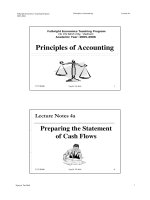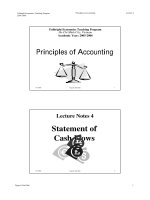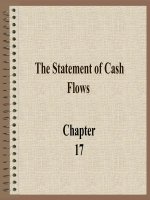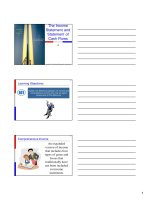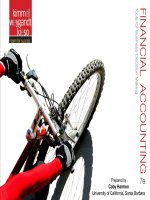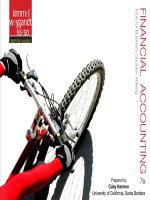Lecture Accounting principles (8th edition) – Chapter 17: Statement of cash flows
Bạn đang xem bản rút gọn của tài liệu. Xem và tải ngay bản đầy đủ của tài liệu tại đây (883.49 KB, 52 trang )
Chapter
17-1
CHAPTER
CHAPTER 17
17
STATEMENT OF CASH FLOWS
Accounting Principles, Eighth Edition
Chapter
17-2
Study Objectives
Study Objectives
1. Indicate the usefulness of the statement of cash flows.
2. Distinguish among operating, investing, and financing
activities.
3. Prepare a statement of cash flows using the indirect method.
4. Analyze the statement of cash flows.
Chapter
17-3
Statement of Cash Flows
Statement of Cash Flows
The
TheStatement
Statementof
of
Cash
CashFlows:
Flows:
Usefulness
Usefulnessand
and
Format
Format
Usefulness
Classifications
Significant
noncash activities
Format
Preparation
Indirect and direct
methods
Chapter
17-4
Preparing
Preparingthe
the
Statement
Statementof
of
Cash
CashFlows—
Flows—
Indirect
IndirectMethod
Method
Step 1: Operating
activities
Step 2: Investing
and financing
activities
Step 3: Net
change in cash
Using
UsingCash
Cash
Flows
Flowsto
toEvaluate
Evaluate
aaCompany
Company
Free cash flow
Usefulness of the Statement of Cash Flows
Usefulness of the Statement of Cash Flows
Provides information to help assess:
1. Entity’s ability to generate future cash flows.
2. Entity’s ability to pay dividends and obligations.
3. Reasons for difference between net income and net cash provided
(used) by operating activities.
4. Cash investing and financing transactions during the period.
Chapter
17-5
LO 1 Indicate the usefulness of the statement of cash flows.
Classification of Cash Flows
Classification of Cash Flows
Operating
Activities
Income Statement
Items
Chapter
17-6
Investing
Activities
Generally Long
Term Asset Items
Financing
Activities
Generally Long
Term Liability
and Equity
Items
LO 2 Distinguish among operating, investing, and financing activities.
Classification of Cash Flows
Classification of Cash Flows
Classification of Typical Inflows and Outflows
Illustration 171
Operating activities Income statement items
Cash inflows:
From sale of goods or services.
From interest received and dividends received.
Cash outflows:
To suppliers for inventory.
To employees for services.
To government for taxes.
To lenders for interest.
To others for expenses.
Chapter
17-7
LO 2 Distinguish among operating, investing, and financing activities.
Classification of Cash Flows
Classification of Cash Flows
Classification of Typical Inflows and Outflows
Illustration 171
Investing activities Changes in investments and longterm assets
Cash inflows:
From sale of property, plant, and equipment.
From sale of investments in debt or equity securities.
From collection of principal on loans to other entities.
Cash outflows:
To purchase property, plant, and equipment.
To purchase investments in debt or equity securities.
To make loans to other entities.
Chapter
17-8
LO 2 Distinguish among operating, investing, and financing activities.
Classification of Cash Flows
Classification of Cash Flows
Classification of Typical Inflows and Outflows
Illustration 171
Financing activities Changes in longterm liabilities and
stockholders’ equity
Cash inflows:
From sale of common stock.
From issuance of longterm debt (bonds and notes).
Cash outflows:
To stockholders as dividends.
To redeem longterm debt or reacquire capital stock
(treasury stock).
Chapter
17-9
LO 2 Distinguish among operating, investing, and financing activities.
Classification of Cash Flows
Classification of Cash Flows
Significant Noncash Activities
1. Issuance of common stock to purchase assets.
2. Conversion of bonds into common stock.
3. Issuance of debt to purchase assets.
4. Exchanges of plant assets.
Companies report these activities in either a separate schedule at the
bottom of the statement of cash flows or in a separate note or
supplementary schedule to the financial statements.
Chapter
17-10
LO 2 Distinguish among operating, investing, and financing activities.
Format of the Statement of Cash Flows
Format of the Statement of Cash Flows
Order of Presentation:
1.
Operating activities.
2.
Investing activities.
3.
Financing activities.
Direct Method
Indirect Method
The cash flows from operating activities section always appears
first, followed by the investing and financing sections.
Chapter
17-11
LO 2 Distinguish among operating, investing, and financing activities.
Format of the Statement of Cash Flows
Format of the Statement of Cash Flows
Illustration 172
Chapter
17-12
LO 2 Distinguish among operating, investing, and financing activities.
Preparing the Statement of Cash Flows
Preparing the Statement of Cash Flows
Three Sources of Information:
1. Comparative balance sheets
2. Current income statement
3. Additional information
Three Major Steps:
Chapter
17-13
Illustration 173
LO 2 Identify the major classifications of cash flows.
Preparing the Statement of Cash Flows
Preparing the Statement of Cash Flows
Three Major Steps:
Chapter
17-14
Illustration 173
LO 2 Identify the major classifications of cash flows.
Preparing the Statement of Cash Flows
Preparing the Statement of Cash Flows
Indirect and Direct Methods
Companies favor the indirect method for
two reasons:
1. It is easier and less costly to prepare,
and
2. It focuses on the differences between
net income and net cash flow from
operating activities.
Chapter
17-15
LO 2 Identify the major classifications of cash flows.
Preparing the Statement of Cash Flows
Preparing the Statement of Cash Flows
Indirect Method
Demonstration
Problem
Illustration 174
Chapter
17-16
LO 3 Prepare a statement of cash flows using the indirect method.
Preparing the Statement of Cash Flows
Preparing the Statement of Cash Flows
Indirect Method
Demonstration
Problem
Illustration 174
Chapter
17-17
LO 3 Prepare a statement of cash flows using the indirect method.
Preparing the Statement of Cash Flows
Preparing the Statement of Cash Flows
Demonstration
Problem
Additional information for 2008:
Illustration 174
1.
The company declared and paid a $29,000 cash dividend.
2.
Issued $110,000 of long-term bonds in direct exchange for land.
3.
A building costing $120,000 and equipment costing $25,000 were
purchased for cash.
4.
The company sold equipment with a book value of $7,000 (cost $8,000,
less accumulated depreciation $1,000) for $4,000 cash.
5.
Issued common stock for $20,000 cash.
6.
Depreciation expense was comprised of $6,000 for building and $3,000
Chapter
LO 3 Prepare a statement of cash flows using the indirect method.
17-18 for equipment.
Preparing the Statement of Cash Flows – Indirect
Preparing the Statement of Cash Flows – Indirect
Method
Method
Step 1: Operating Activities
Determine net cash provided/used by operating activities by converting
net income from an accrual basis to a cash basis.
Common adjustments to Net Income (Loss):
Add back noncash expenses (depreciation and amortization
expense).
Deduct gains and add losses.
Changes in current assets and current liabilities.
Chapter
17-19
LO 3 Prepare a statement of cash flows using the indirect method.
Step 1: Operating Activities
Step 1: Operating Activities
Question
Which is an example of a cash flow from an operating activity?
a. Payment of cash to lenders for interest.
b. Receipt of cash from the sale of capital stock.
c. Payment of cash dividends to the company’s stockholders.
d. None of the above.
Chapter
17-20
LO 3 Prepare a statement of cash flows using the indirect method.
Step 1: Operating Activities
Step 1: Operating Activities
Depreciation Expense
Although depreciation expense reduces net income, it does not reduce
cash. Depreciation is a noncash charge. The company must add it back
to net income.
Illustration 176
Cash flows from operating activities:
Net income
Adjustments to reconcile net income to net cash
provided by operating activities:
Depreciation expense
Net cash provided by operating activities
Chapter
17-21
$
145,000
$
9,000
154,000
LO 3 Prepare a statement of cash flows using the indirect method.
Operating Activities
Operating Activities
Loss on Sale of Equipment
Because companies report as a source of cash in the investing activities
section the actual amount of cash received from the sale:
Any loss on sale is added to net income in the operating section.
Any gain on sale is deducted from net income in the operating
section.
Chapter
17-22
LO 3 Prepare a statement of cash flows using the indirect method.
Operating Activities
Operating Activities
Loss on Sale of Equipment
Illustration 177
Cash flows from operating activities:
Net income
Adjustments to reconcile net income to net cash
provided by operating activities:
Depreciation expense
Loss on sale of equipment
Net cash provided by operating activities
Chapter
17-23
$
145,000
$
9,000
3,000
157,000
LO 3 Prepare a statement of cash flows using the indirect method.
Operating Activities
Operating Activities
Changes to Noncash Current Asset Accounts
When the Accounts Receivable balance decreases, cash receipts are higher
than revenue earned under the accrual basis.
Accounts Receivable
1/1/08
Balance
Revenues
12/31/08 Balance
30,000
507,000
Illustration 178
Receipts from customers 517,000
20,000
Therefore, the company adds to net income the amount of the decrease in
accounts receivable.
Chapter
17-24
LO 3 Prepare a statement of cash flows using the indirect method.
Operating Activities
Operating Activities
Changes to Noncash Current Asset Accounts
Illustration 179
Cash flows from operating activities:
Net income
Adjustments to reconcile net income to net cash
provided by operating activities:
Depreciation expense
Loss on sale of equipment
Decrease in accounts receivable
Net cash provided by operating activities
Chapter
17-25
$
145,000
$
9,000
3,000
10,000
167,000
LO 3 Prepare a statement of cash flows using the indirect method.
